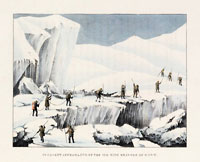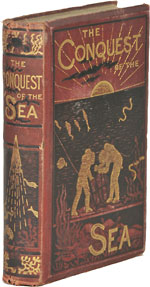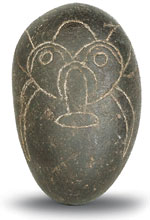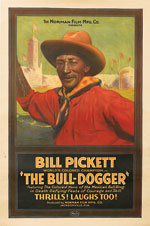 Ian McKay’s weekly column in Antiques Trade Gazette has been running for more than 30 years.
Ian McKay’s weekly column in Antiques Trade Gazette has been running for more than 30 years. All Over the Map
Going Up, Going Down
Narrative of an Ascent to the Summit of Mont-Blanc, by Charles Fellows, Euros 11,760 ($15,645) at Alde of Paris on December 18, and The Conquest of the Sea, by Henry Siebe, £964 ($1,250) at Dominic Winter of South Cerney, January 26-27.
A much sought-after classic of mountaineering literature, Fellows’ book is an account of the fourteenth ascent of the famous Alpine peak. One of just fifty copies that he had privately printed in 1827, it is also one of around twenty or so recorded copies in which the ten lithographed plates have been colored.
Bearing the bookplate of Oscar V. Viney, someone whose name I have seen attached to other mountaineering books at auction, this copy made even more than some inscribed and colored copies have done in the past.
Published in 1873,The Conquest of the Sea is a scarce, early book on diving and divers by the son of August Siebe, a German-born artillery officer who had moved to London following the Napoleonic wars and pursued a career in engineering. It was this elder Siebe who devised the standard and familiar diving apparatus of detachable helmet and canvas suit, and who, in partnership with his son-in-law, founded the firm whose name became internationally synonymous with diving equipment, Siebe Gorman.
The South Cerney sale also included an early trade catalogue and diving instruction manual issued by Siebe Gorman, c.1888. The Manual for Divers and Illustrated Catalogue lacked one of the twenty-three engraved illustrations, and the wrappers were torn and crudely repaired with tape, but a facsimile copy of the same work was included to cover any shortcomings, and it sold at £846 ($1,335).
Middle Passage Ballast & Mexican Bulldogging
Carved ballast stone from a sixteenth-century slave ship, ($24,000) and a poster for the 1921 film, The Bull-Dogger, ($12,000) at Swann Galleries of New York on March 10.
Two very different items from over five hundred lots that made up a sale of African-Americana are illustrated here.
Recovered in 1992 from a wreck found on the Little Bahama Banks, a well known ships’ graveyard, the nine inch-long, ovoid ballast stone has had a mask-like image of an elephant’s head scratched onto its surface, and the suggestion is that it was done by one of the ship’s cargo of slaves during the long Middle Passage from Africa to the West Indies. Veteran diver Herbert Humphreys had been searching for the stern section of a Spanish treasure ship lost in 1656 but found instead two different wrecks from the previous century. One was later dubbed the tumbaga wreck, for a type of gold bar found there; the other was the early English slave ship of c.1570-75 in which this stone was found.
Bill Pickett, who starred as ‘The World’s Colored Champion’ in the 1921 movie The Bull-Dogger, was a genuine cowboy and is credited with inventing, in the course of his daily work, what rodeo-goers now know as bulldogging, or steer wrestling. Florida’s Norman Film Studios produced many classic all-black films in the 1920s, but Swann Galleries suggest that this one, “Featuring the Colored Hero of the Mexican Bull Ring in Death Defying Feats of Courage and Skill,” is quite possibly the rarest of the posters.











